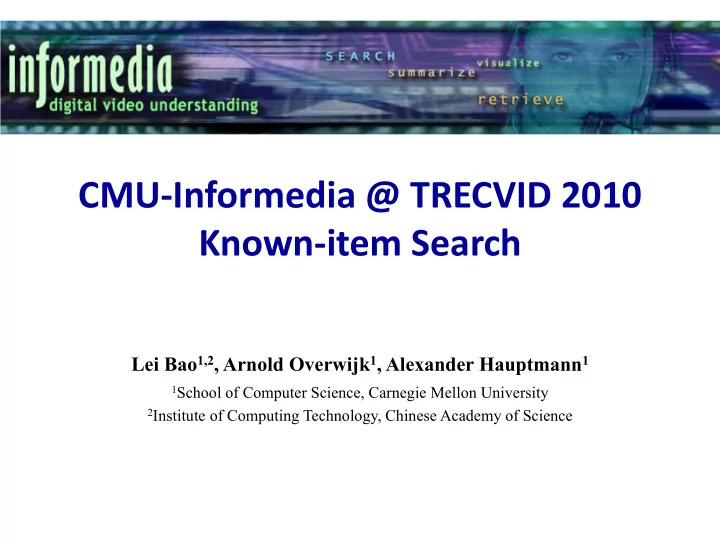

CMU ‐ Informedia @ TRECVID 2010 Known ‐ item Search Lei Bao 1,2 , Arnold Overwijk 1 , Alexander Hauptmann 1 1 School of Computer Science, Carnegie Mellon University 2 Institute of Computing Technology, Chinese Academy of Science
Outline � System overview � Three retrieval systems � Text-based retrieval with Lemur � Visual-based retrieval with Bipartite Graph Propagation Model � LDA-based multi-modal retrieval � Multiple query-class dependent fusion � Conclusions and future work
System overview
Text ‐ based Retrieval with Lemur � six query types � keywords query � keywords filtered by Flickr tags � expand keywords by Flickr tags � visual cues query � visual cues filtered by Flickr tags � expand visual cues by Flickr tags � six fields � 3 fields out of 74 in metadata: � description � title � keywords � Automatic Speech Recognition(ASR) � Microsoft Speech SDK 5.1 � speech transcription from LIMSI � Optical Character Recognition (OCR) � all metadata fields, ASR and OCR are combined into 1 field � fusion: give different weights for fields and query types.
Text ‐ based Retrieval with Lemur � six query types in six fields, tested on 122 sample topics all description title keywords ASR OCR 0.2549 0.1787 0.0863 0 0.0636 0.0328 keywords 0.2911 0.1688 0.0862 0 0.0661 0.0362 keywords.filtered 0.0680 0.0024 0.0082 0 0.0021 0 keywords.expand 0.2640 0.1476 0.0842 0 0.0494 0.0351 visual cues 0.2785 0.1497 0.0998 0.0027 0.0709 0.0292 visual cues.flitered visual cues.expand 0.0569 0.0020 0.0171 0.0006 0.0007 0.0007
Visual ‐ based Retrieval with Bipartite Graph Propagation Model � Explicit concepts � pre-defined from human perspective � 130 concepts for semantic indexing task � 12 color concepts � Implicit concepts (latent topics) � discovered from computer perspective � 200 implicit concepts: discovered by Latent Dirichlet Allocation (LDA) � Bipartite Graph Propagation Model-based Retrieval � the relationship between query and explicit and implicit concepts can be described in a bipartite graph � after propagation stability, concept nodes with stronger connections with query nodes will win. The score of each concept node indicates its relevance to the queries
Visual ‐ based Retrieval with Bipartite Graph Propagation Model � Are query examples helpful? � Are 12 color concepts helpful? � Are implicit concepts helpful? � Is the visual-based retrieval helpful? � 36 queries out of 420 have over 0.01 performance � in these 36 queries, 16 of them have zero performance in text-based retrieval. explicit explicit implicit explicit + implicit (130) (130 +12 colors) (200) (342) query-by-keywords 0.0054 0.0064 ------- ------- query-by-examples 0.0070 0.0075 0.0047 0.0078 keywords+examples 0.0079 0.0094 ------- 0.0099
Visual ‐ based Retrieval with Bipartite Graph Propagation Model � some reasons for the poor performance � concept detectors � 304 topics out of 420 contain at least one of the predefined concept � only 27 topics out of these 304 have over 0.01 performance � shot-based retrieval vs. video-based retrieval � 0185: find the video with three black horses eating from a pile of hay with tress and a small red building behind them Figure 1. keyframes of the answer video for topic 0185. � image examples vs. video examples
LDA ‐ based Multi ‐ modal Retrieval � A generative topic model to describe the joint distribution of textual and visual features � the generative process of a video with N t text words and N v SIFT visual words � draw a topic proportion θ | α ~ Dir( α ) � for each text word w t � choose a topic z ~ multinomial( θ ) � choose a word w t from p(w t |z, β t ), a multinomial probability conditioned on the topic z � for each visual word w v � choose a topic z ~ multinomial( θ ) � choose a word w t from p(w v |z, β v ), a multinomial probability conditioned on the topic z
Multiple Query ‐ class Dependent Fusion � Ranking features � for each query, its ranking features is a N*K matrix. N is the number of videos in collection. K is the number of experts. � assumption: assign the queries with similar ranking features into one class helps to optimize weights for the class-dependent fusion. � Present query based on ranking features � train “ranking words” by clustering, where each word is a K- dimensional vector � present each query as a bag of “ranking words” � Cluster queries into several classes � Optimize fusion weights for each class by exhaustive search
Multiple Query ‐ class Dependent Fusion � Fuse the results from six fields with keywords query � best run out of six � single query class dependent fusion � 5 query classes dependent fusion 0.26 0.25 mean inverted rank 0.24 0.23 0.22 0.21 0.2 best run out of six single query class 5 query classes dependent fusion dependent fusion
Conclusions & Future Work � Conclusions � textual information contributed the most � visual-based retrieval is promising � Future Work � find a better formulation of the query � extend the visual-based retrieval from shot-based to video- based � re-rank the text-based result with visual feature � use multiple query-class dependent fusion to combine the text- based and visual-based retrieval
Recommend
More recommend